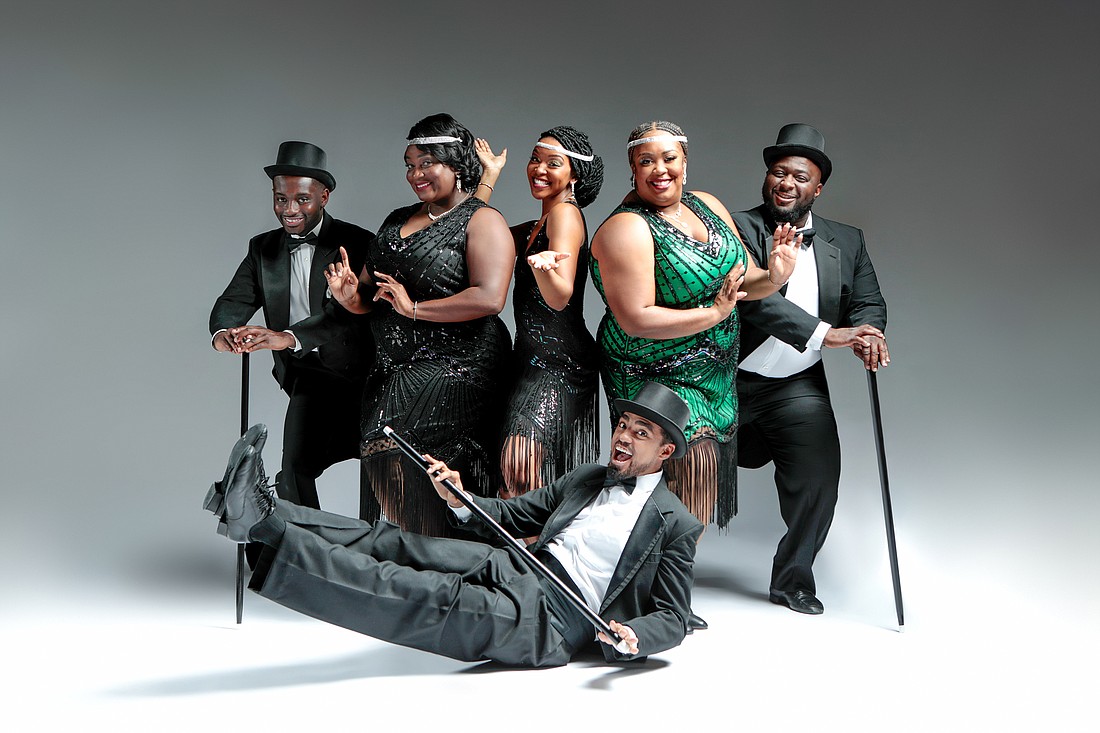- April 9, 2025
-
-
Loading

Loading

The “Great White Way” is not so white. Not now, not ever.
Since the early days, Broadway musicals have told Black people’s stories. Broadway also put many Black performers, lyricists and composers to work.
Sounds good, right? But it wasn’t all good.
In the bad old days, Broadway also put Black people down — both on stage and off.
In 2017, Nate Jacobs decided to reclaim this uneasy cultural legacy with an original Westcoast Black Theatre Troupe production. His ambitious “Broadway in Black” was the result.
It’s back on stage this year — and even more ambitious.
The show’s hard to describe, but I’ll try.
“Broadway in Black” is …
This unique theatrical experience is …
Well, it isn’t a musical, exactly. The show’s more like a greatest hits album of songs from Broadway musicals by and/or about Black people.
The tunes are in chronological order, mostly. (Based on when the songs happen, not when they were created.)
As the timeline begins in 1902, it covers the full genre spectrum — ragtime, reggae, jazz, rock, R&B, calypso, you name it. All that no anachronisms. Choreographer Donald Frison deftly matches the dance styles to each song’s era. (Nobody breakdances to tunes from the 1920s.)
This show’s 14 performers are the hardest-working men and women in Sarasota show business.
They’ve got plenty of work to do. (If my count is accurate, a total of 54 songs.)
But their work goes far beyond the mere quantity of songs that Music Director Matthew McKinnon arranged for this production. Because “Broadway in Black” is far more than a revue.
Jacobs took the 54 tunes from 100-plus years of musicals. But he never takes them out of context.
The singers don’t simply sing these songs. They perform them — in costume and in character. Nobody phones it in, either. Each stage artist is utterly committed to every song. (The backstage artists are equally committed — especially the live band.)
So what can audiences expect?
Here are just a few highlights. Because “Broadway in Black” is 100-plus years of highlights, narrowing it down is tough.
But here goes.
Duke Ellington gets the royal treatment he’s due in a moody blue “Mood Indigo” (Ariel Blue, Katherine Taylor, Syreeta Banks) and a sizzling “Hit Me with a Hot Note” (Helen Jane Planchet). Fats Waller’s “How Ya Baby” is suitably seductive. (Michael Meija-Mendez and everybody).
Eubie Blake’s “I’m Just Wild About Harry” is too (Ariel Blue, Syreeta Banks and Delores McKenzie).
Syreeta Banks melts every heart in the room with her soulful rendition of George and Ira Gershwin’s “Summertime,” a mother’s dream of her child’s bright future.
Stephen Flaherty and Lynn Ahrens’ “Your Daddy’s Son” is another mother’s dream (Helen Jane Planchet). One mother sings a hopeful lullaby she doesn’t believe. The other believes every word she sings.
C. Smalls’ high-voltage numbers from “The Wiz” include “Ease on Down the Road” and “So You Wanted to Meet the Wizard.” (Derric Gobourne Jr. is hilariously boneless as The Scarecrow; Meija-Mendez is positively reptilian as a Kansas City grifter posing as the Wizard of Oz.)
Moving from technicolor fantasy to black-and-blue reality, McKenzie paints a shattering portrait of abuse in “The Color Purple” (music by Brenda Russell, Allee Willis, and Stephen Bray).
Blue is a lightning rod for Tina Turner’s life force in her electrifying take on John Fogerty’s “Proud Mary.” (Kudos to Darci Collins’ costume design. Her jingle-jangle miniskirt nails Tina Turner’s post-Ike look.)
Tom Eyen and Henry Krieger’s tunes put the spotlight on a 1960s power trio of three powerful black women. These “Dreamgirls” had both sweet dreams and nightmares. Taylor, Jai Shanae, and Brentney J evoke their supreme ambitions on “We are Dreamgirls.” Taylor summons the lead singer’s deal with a show-biz devil on the low-down “Steppin’ to the Bad Side.
That’s a fairly arbitrary selection of the good stuff.
In this show, it’s all good. Any other random sample would be equally fun
“Broadway in Black” is a great show packed with great songs. There’s enough here for two great shows.
Where I sit, that’s not such a bad idea.
To a critic with a notebook, this show is like a graduate level course in the history of Black musical theater. But I didn’t see any other notebooks. Everybody else was just digging the show — and occasionally hopping and bopping in their seats in time to the music. Who could criticize that?
My final thumbs-up goes to C. Alan Anderson.
Not a singer, dancer, actor, lighting designer, costume designer, set designer, director or choreographer. He’s the architect who designed WBTT’s shiny new, state-of the-art auditorium.
WBTT’s talents have always been world-class. Their reinvented theater space is finally worthy of their talents.
And that deserves a round of applause.